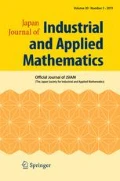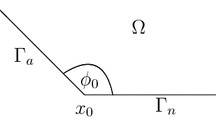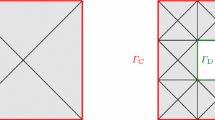Abstract
In this paper we discuss the numerical implementation of a systematic method for the exact boundary controllability of the wave equation, concentrating on the particular case of Dirichlet controls. The numerical methods described here consist in a combination of: finite element approximations for the space discretization; explicit finite difference schemes for the time discretization; a preconditioned conjugate gradient algorithm for the solution of the discrete problems; a pre/post processing technique based on a biharmonic Tychonoff regularization. The efficiency of the computational methodology is illustrated by the results of numerical experiments.
Similar content being viewed by others
References
J.L. Lions, Controlabilité exacte des systèmes distribués. C. R. Acad. Sci. Paris,302 (1986), 471–475.
J.L. Lions, Exact Controllability, stabilization and perturbations for distributed systems. SIAM Review.30 (1988), 1–68.
J.L. Lions, Contrôlabilité Exacte, perturbations et Stabilisation des Systèmes Distribués. Volumes 1 and 2. Masson, Paris, 1988.
R. Glowinski, C.H. Li, J.L. Lions, A numerical approach to the exact boundary controllability of the wave equation (II) Dirichlet controls: Further numerical experiments (to appear).
R.A. Adams, Sobolev Spaces. Academic Press, New York, 1975.
J.L. Lions, E. Magenes, Nonhomogeneous Boundary Value Problems and Applications. Vols. 1 and 2, Springer-Verlag, Berlin, 1972.
L.F. Ho, Observabilité frontière de l’équation des ondes. C. R. Acad. Sci. Paris,302 (1986), 443–446.
D.L. Russel, A unified boundary controllability theory. Studies in Appl. Math.,52 (1973), 189–211.
D.L. Russel, Controllability and Stabilizability theory for linear partial differential equations. Recent progress and open questions, SIAM Review,20 (1978), 639–739.
W. Littman, Boundary control theory for hyperbolic and parabolic equations with constant coefficients. Ann. Scuola Norm. Sup. Pisa IV, (1978), 567–580.
J. Lagnese, Boundary value control of a class of hyperbolic equations in a general domain. SIAM J. Control Optim.15 (1977), 973–983.
J. Daniel, The Approximate Minimization of Functionals. Prentice Hall, Englewood Cliffs, N. J., 1970.
R. Glowinski and O. Pironneau, Numerical methods for the first biharmonic equation and for the two-dimensional Stokes problem. SIAM Rev.21(2) (1979), 167–212.
R. Glowinski, Numerical Methods for Nonlinear Variational Problems. Springer-Verlag, New York, 1984.
P. Swarztrauber, The method of cyclic reduction, Fourier analysis and the FACR algorithm for the discrete solution of Poisson’s equation on a rectangle. SIAM Rev.,19 (1977), 490–501.
P.A. Raviart and J.M. Thomas, A mixed finite element method for second order elliptic equations. Mathematical Aspects of the Finite Element Method, Lecture Notes in Math. Vol. 606, Springer-Verlag, Heidelberg, 1977, 292–315.
R. Lattes et J.L. Lions, Méthode de Quasi-Réversibilité et Applications. Dunod, Paris, 1967.
J.L. Lions, Perturbations Singulières dans les Problèmes aux Limites et en Contrôle Optimal. Lecture Notes in Math., Vol. 323, Springer-Verlag, Heidelberg, 1973.
J.L. Lions, A remark on the approximation of nonhomogeneous hyperbolic boundary value problems. Vistas in Applied Mathematics (eds. A.V. Balakrishnan, A.A. Dorodnitsyn, J.L. Lions), Optimization Software, Inc., New York, 1986, 114–126.
A. El Jai et A.J. Pritchard, Capteurs et Actionneurs dans l’Analyse des Systèmes Distribués. Masson, Paris, 1986.
A. El Jai et A. Gonzales, Actionneurs et Contrôlabilité des Systèmes Hyperboliques. Univ. Perpignan Research Report, Perpignan, France, 1987.
J.E. Dennis and R.B. Schnabel, A View of Unconstrained Optimization. Handbooks in Operations Research and Management Science, Vol. 1, Optimization (eds. A.H.G. Rinneoy Kan, M.J. Todd), North-Holland, Amsterdam (to appear).
Author information
Authors and Affiliations
Additional information
Dedicated to Jim Douglas for his 60th Birthday
An erratum to this article is available at http://dx.doi.org/10.1007/BF03167859.
About this article
Cite this article
Glowinski, R., Li, CH. & Lions, JL. A numerical approach to the exact boundary controllability of the wave equation (I) Dirichlet controls: Description of the numerical methods. Japan J. Appl. Math. 7, 1–76 (1990). https://doi.org/10.1007/BF03167891
Received:
Issue Date:
DOI: https://doi.org/10.1007/BF03167891




